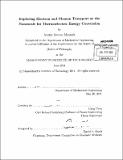Exploring electron and phonon transport at the nanoscale for thermoelectric energy conversion
Author(s)
Minnich, Austin Jerome
DownloadFull printable version (9.015Mb)
Other Contributors
Massachusetts Institute of Technology. Dept. of Mechanical Engineering.
Advisor
Gang Chen.
Terms of use
Metadata
Show full item recordAbstract
Thermoelectric materials are capable of solid-state direct heat to electricity energy conversion and are ideal for waste heat recovery applications due to their simplicity, reliability, and lack of environmentally harmful working fluids. Recently, nanostructured thermoelectrics have demonstrated remarkably enhanced energy conversion efficiencies, primarily due to a reduction in lattice thermal conductivity. Despite these advances, much remains unknown about heat transport in these materials, and further efficiency improvements will require a detailed understanding of how the heat carriers, electrons and phonons, are affected by nanostructures. To elucidate these processes, in this thesis we investigate nanoscale transport using both modeling and experiment. The first portion of the thesis studies how electrons and phonons are affected by grain boundaries in nanocomposite thermoelectric materials, where the grain sizes are smaller than mean free paths (MFPs). We use the Boltzmann transport equation (BTE) and a new grain boundary scattering model to understand how thermoelectric properties are affected in nanocomposites, as well as to identify strategies which could lead to more efficient materials. The second portion of the thesis focuses on determining how to more directly measure heat carrier properties like frequency-dependent MFPs. Knowledge of phonon MFPs is crucial to understanding and engineering nanoscale transport, yet MFPs are largely unknown even for bulk materials and few experimental techniques exist to measure them. We show that performing macroscopic measurements cannot reveal the MFPs; instead, we must study transport at the scales of the MFPs, in the quasi- ballistic transport regime. To investigate transport at these small length scales, we first numerically solve the frequency-dependent phonon BTE, which is valid even in the absence of local thermal equilibrium, unlike heat diffusion theory. Next, we introduce a novel thermal conductivity spectroscopy technique which can measure MFP distributions over a wide range of length scales and materials using observations of quasi-ballistic heat transfer in a pump-probe experiment. By observing the changes in thermal resistance as a heated area size is systematically varied, the thermal conductivity contributions from different MFP phonons can be determined. We present the first experimental measurements of the MFP distribution in silicon at cryogenic temperatures. Finally, we develop a modification of this technique which permits us to study transport at scales much smaller than the diffraction limit of approximately one micron. It is important to access these length scales as many technologically relevant materials like thermoelectrics have MFPs in the deep submicron regime. To beat the diffraction limit, we use electron-beam lithography to pattern metallic nano dot arrays with diameters in the hundreds of nanometers range. Because the effective length scale for heat transfer is the dot diameter rather than the optical beam diameter, we are able to study nanoscale heat transfer while still achieving ultrafast time resolution. We demonstrate the modified technique by measuring the MFP distribution in sapphire. Considering the crucial importance of the knowledge of MFPs to understanding and engineering nanoscale transport, we expect these newly developed techniques to be useful for a variety of energy applications, particularly for thermoelectrics, as well as for gaining a fundamental understanding of nanoscale heat transport.
Description
Thesis (Ph. D.)--Massachusetts Institute of Technology, Dept. of Mechanical Engineering, 2011. Cataloged from PDF version of thesis. Includes bibliographical references (p. 147-155).
Date issued
2011Department
Massachusetts Institute of Technology. Department of Mechanical EngineeringPublisher
Massachusetts Institute of Technology
Keywords
Mechanical Engineering.